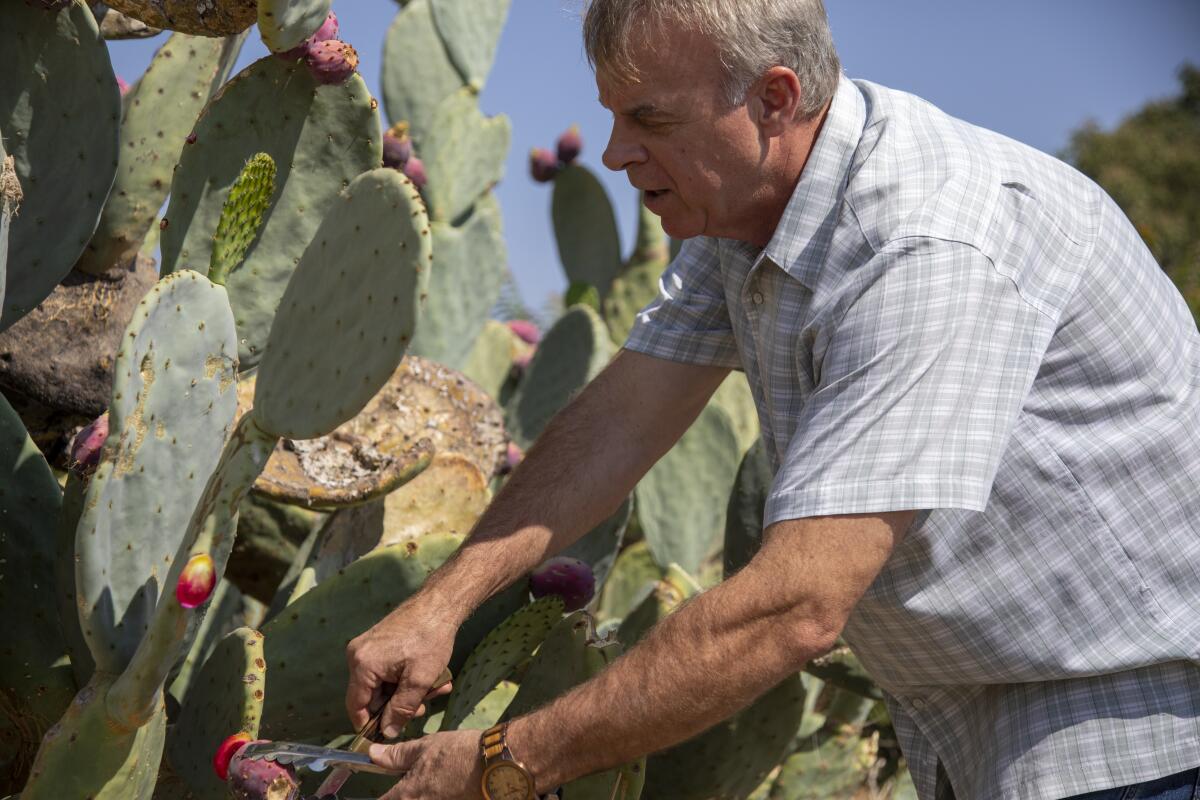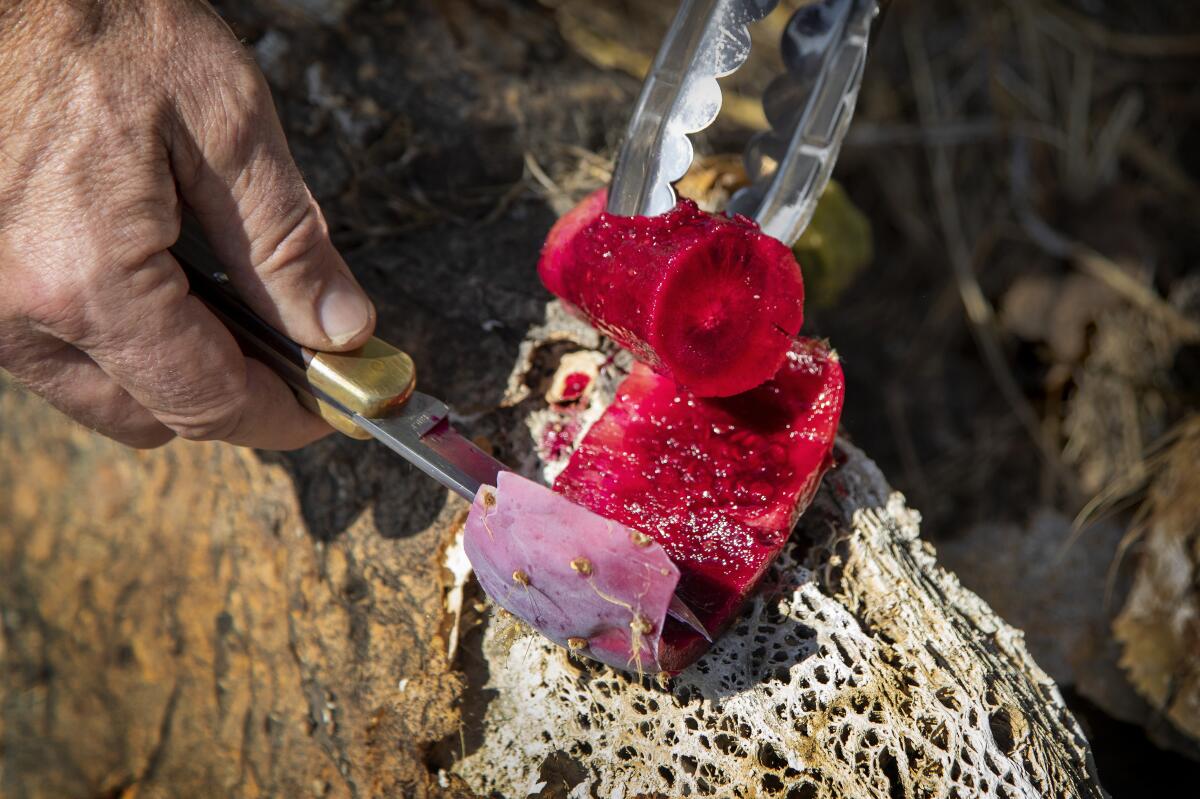‘Let’s go foraging.’ Learn how to forage like a pro on this Central Coast tour

- Share via
ATASCADERO, Calif. — In the late 1800s, Eric Olson’s forebears, the Fitzells, ran one of the first drugstores in Eureka, Calif.
The way he tells the story, they foraged on their 500-acre ranch, gathering herbs, berries and other medicinal botanicals. The family then concocted elixirs dispensed in small bottles of alcohol produced in a legal still and sold out of the Fitzells’ Pharmacy on F Street.
Fast-forward 140 years and Olson, a chef, is continuing the family tradition more than 500 miles south. With his wife, Anna, he runs Central Coast Distillery in Atascadero, where he crafts high-end spirits under the Forager and Grave Digger labels, cooks for groups, and leads what he calls “wildcrafting” outings.
The couple opened their distillery in 2017 after decades of working for luxury properties such as the Ojai Valley Inn, Carmel Valley Ranch and Pebble Beach Resorts.
“But I didn’t want [it] to be just another distillery. I wanted to do something different,” Olson told me on a recent visit to the facility, where he makes tequila, smoky-flavored mezcal, gin, rum and other spirits in a 50-gallon stainless still or a 100-gallon copper still from Kentucky.
“I didn’t want to get ingredients for my cocktails from a farmers market either, because that’s been done for a couple of decades now,” he said. “I thought to myself, ‘Let’s go foraging.’”
From a lighthouse in Crescent City, to trees changing colors in the Sierra, to funky art installations near the Salton Sea, these are the best things to do in the Golden State in the fall.
He decided to offer visitors an opportunity to forage with him — a skill he learned while hunting with his uncles and at a Marine Corps jungle warfare school — and learn about the epicurean and medicinal qualities of botanicals found in San Luis Obispo County.
Olson showed our small tour group how agave is roasted, mashed and fermented to produce tequila. (He calls his brew “agave spirit” because international law says alcohol sold as tequila must be produced in the Mexican state of Jalisco and a few other locales.)
We then headed out to glean prickly pears from a roadside nopal cactus and collect bay laurel leaves, fennel, bright-red toyon berries and elderberry in the hills west of Paso Robles.

Our first stop was Mission San Miguel Arcángel, established by the Franciscan order in 1797. Olson found ornamental agaves in the parking lot and told us about the plant’s multiple uses besides tequila, including making soap, paper and rope and treating wounds, burns and skin infections.
We next visited a nopal cactus in a roadside right of way across from the mission, where Olson cut off a small pad he said could be used to make lemonade.
He also sliced off several prickly pears, which are a rich beet-like red inside, have a tart and mildly sweet flavor, and can be used to make jams and jellies or spark a cocktail. The fruit has anti-inflammatory properties, according to the Mayo Clinic.
Olson said he forages pretty much at will. “I figure if there’s not a fence or sign that says ‘no trespassing,’ it’s fair game, especially if a plant is beside a road.”
Forage for edible seaweed on a tour that includes a ramen lunch made with the day’s harvest.
We left the mission and headed into the hills west of Paso Robles on California 46, where we gathered leaves and nuts from a bay laurel tree and learned how the plant can be used in cocktails and cooking and to ease pain and heal wounds.
He cautioned us to stay clear of poison oak, with its shiny three-leaf clusters, and told us how to make pine needle tea. He pointed out the shiny red bark of the manzanita tree, which has a berry that can be used as a spice. Indigenous people made an herbal tea from its leaves and berries to treat poison oak rash, bronchitis, and stomach and kidney ailments.

We also gathered wild fennel, which tastes a bit like anise or licorice, is widely used in cooking and may possess antibacterial and anti-inflammatory properties
Olson warned us that fennel and hemlock — used to poison the philosopher Socrates in 399 BC — have a similar appearance, though hemlock’s leaves are shaped like triangles and fennel’s foliage is feathery and dill-like.
“Which is why foraging on your own can be dangerous unless you know what you are doing,” he said. “And why I recommend going with a guide.”
Back at the distillery, Olson muddled the prickly pear for use in several cocktails, including one with lime, agave syrup and a smoky mezcal. To a Forager gin, he added a touch of fennel.
“I usually like to stick to the classics, but then put a personal little twist on them with something that we foraged,” he said.
My favorite cocktail was made with mango sorbet from Leo Leo Gelato in Paso Robles and vodka made with locally sourced and foraged honey, toyon berry flowers and Ojai Pixie tangerines, then garnished with fresh rosemary and thyme.
If you go
Central Coast Distillery, 5804 Traffic Way, Atascadero, Calif.; foragerspirits.net.
Ride on the Wild Side outings cost $125 per person; groups limited to six.
More to Read
Sign up for The Wild
We’ll help you find the best places to hike, bike and run, as well as the perfect silent spots for meditation and yoga.
You may occasionally receive promotional content from the Los Angeles Times.







